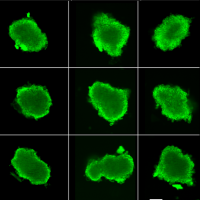 Drug discovery and development is a complex and time-consuming process that requires extensive testing to ensure the efficacy and safety of potential drugs. Traditionally, animal studies have been used to assess the distribution of biologicals for drug development. However, these studies are costly, time-consuming, and raise ethical concerns. In vitro models offer a cost-effective and time-saving alternative to animal studies for drug development. In this blog post, we will focus on how Visikol’s in vitro Antibody Pharmacokinetics Assay can help accelerate drug discovery and development by providing a high-throughput screening solution. We will highlight the benefits of using in vitro models and discuss how they can be used to generate data quickly and efficiently. We will also discuss how the assay can be used to screen for the relative differences in distribution of biologicals in solid tumor models and how this can help predict in vivo outcomes.
Drug discovery and development is a complex and time-consuming process that requires extensive testing to ensure the efficacy and safety of potential drugs. Traditionally, animal studies have been used to assess the distribution of biologicals for drug development. However, these studies are costly, time-consuming, and raise ethical concerns. In vitro models offer a cost-effective and time-saving alternative to animal studies for drug development. In this blog post, we will focus on how Visikol’s in vitro Antibody Pharmacokinetics Assay can help accelerate drug discovery and development by providing a high-throughput screening solution. We will highlight the benefits of using in vitro models and discuss how they can be used to generate data quickly and efficiently. We will also discuss how the assay can be used to screen for the relative differences in distribution of biologicals in solid tumor models and how this can help predict in vivo outcomes.
In vitro models are laboratory-based systems that mimic the in vivo environment. These models are used to study biological processes and test the efficacy and safety of potential drugs. In vitro models offer several benefits over animal studies, including cost-effectiveness, time-saving, and the ability to screen a large number of compounds in a high-throughput manner. In vitro models also allow for more precise control over experimental conditions and can provide insights into mechanisms of action.
Antibody Pharmacokinetics Assay
Visikol offers an in vitro Antibody Pharmacokinetics Assay that measures the distribution of biologicals, including antibody drugs, into solid tumor models. The assay utilizes tumor spheroid models and high content confocal imaging to assess the distance and quantity of antibody penetration into tumor spheroids. The assay can screen the relative differences in distribution of various biologicals, including antibody drug conjugates, antibody fragments, alternate domain antibodies, affibodies, and nanobodies. The assay can measure distribution curves, velocity curves, TD50 values, and concentration-time curves. The assay offers a cost-effective and time-saving alternative to animal studies for drug development.
Solid tumor models are three-dimensional models of tumors that are used in drug development to assess the efficacy and safety of potential drugs. They are more representative of the in vivo tumor microenvironment than traditional two-dimensional cell culture models. The in vitro Antibody Pharmacokinetics Assay can be used to screen for relative differences in distribution of biologicals in solid tumor models by utilizing tumor spheroid models and high content confocal imaging to assess the distance and quantity of antibody penetration into tumor spheroids.
More Information on In Vitro Models
The accuracy of in vitro model results in predicting in vivo outcomes can vary depending on the complexity of the system being modeled and the experimental conditions used. However, in vitro models can provide valuable insights into mechanisms of action and can be used to screen a large number of compounds in a high-throughput manner.
Limitations to using in vitro models in drug discovery and development include the inability to fully replicate the complexity of in vivo systems and the potential for experimental artifacts. However, these limitations can be overcome by carefully designing experiments and using appropriate controls.
Other in vitro models available for drug discovery and development include 3D cell culture models, tissue imaging and analysis services, digital pathology and slide analysis, and custom drug discovery solutions. These models offer a range of options for drug discovery and development and can be tailored to meet specific research needs.
In conclusion, in vitro models offer a cost-effective and time-saving alternative to animal studies for drug discovery and development. The Antibody Pharmacokinetics Assay provides a high-throughput screening solution that can be used to assess the distribution of biologicals in solid tumor models. In vitro models can provide valuable insights into mechanisms of action and can be used to screen a large number of compounds in a high-throughput manner. While limitations to using in vitro models exist, careful experimental design and appropriate controls can overcome these limitations.
Reach out to a member of our team if you’re interested in learning more about this assay!
